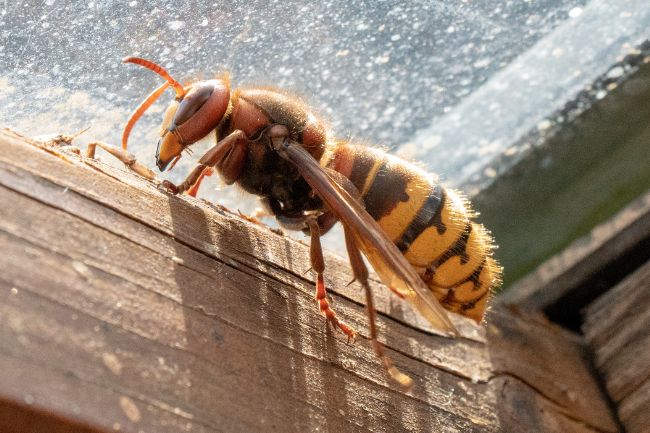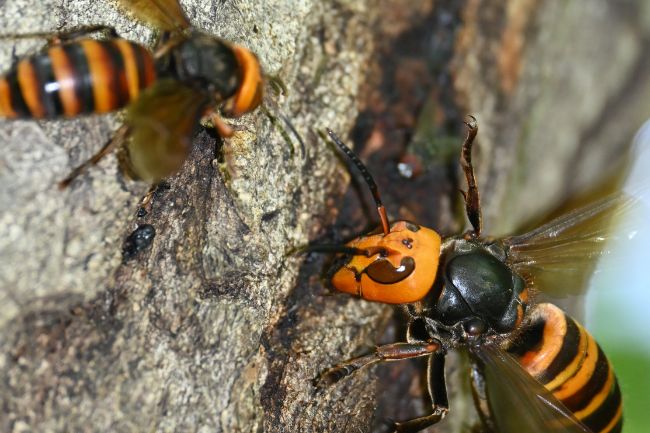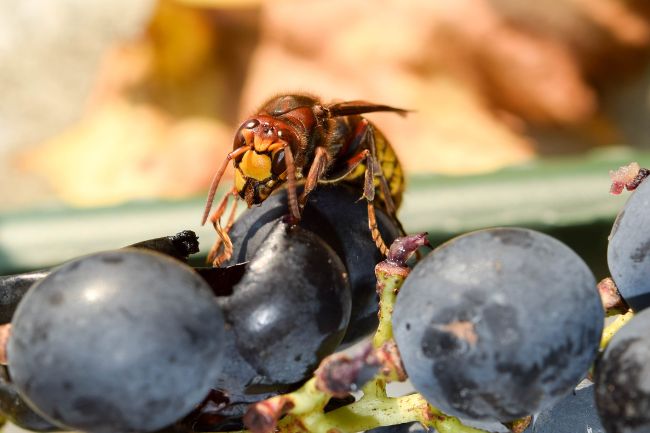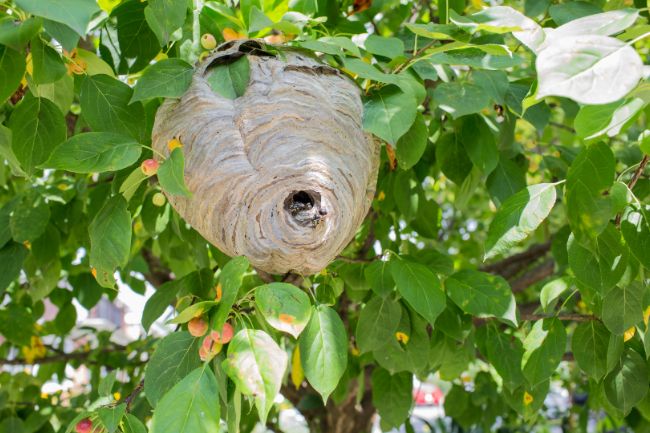Many animals disappear in the winter months, but it’s not always easy to know where they’ve gone. Some leave for warmer climates, some hibernate and others simply die. As hornets are similar in many ways to bees it might be easy to assume they can survive in their hive over winter, yet unfortunately, they aren’t quite tough enough to survive the cold.
This article explores what happens to hornets over winter and how they have adapted to the changing seasons.
Types of Hornets and Their Habits
There are 22 species of hornet across the world. Hornets are a type of wasp, though they are a separate genera due to their wider heads and larger, rounder bodies. Most look very similar to wasps, having the same black and yellow striped bodies and distinctive wasp waists.
Hornets are eusocial insects, meaning they live in colonies, where all individuals are related and work towards looking after the offspring of one queen. Most hornets live in paper nests that they build by chewing up wood and forming the pulp into a distinctive pear-like shaped nest with their mouths.
| Hornet Species | Nest Location | Nest Size |
|---|---|---|
| Asian Giant Hornet | Underground burrows | Large, can reach over 1 foot (30 cm) in diameter |
| European Hornet | High in trees or buildings | Moderate, typically around 12 inches (30 cm) in diameter |
| Bald-Faced Hornet | High in trees or structures | Large, often exceeding 2 feet (70 cm) in length |
| Oriental Hornet | Underground burrows | Moderate, around 10 inches (25 cm) in diameter |
Inside the nest are hexagonal cells, within which the young are fed until they pupate and emerge as adults. Initially the nest is built by a solitary queen, who gives birth to workers and males. The workers are all female and do not produce young. These workers then take over feeding and raising the young, and looking after the queen.
Eventually young queens are born, and they and the males will leave the nest in order to mate with others from other nests. As winter arrives all of the hornets will die, other than the new queens, who will overwinter tucked away somewhere safe, and emerge to form a new nest the following year.

Also read: Ground-Nesting Hornets: Where Do They Live?
Winter Challenges for Hornets
Over the summer the nest will continue to grow, with the workers continuing to expand the nest as new workers are born. Hornets are largely carnivores, and will hunt spiders, caterpillars, flies and anything small enough for them to tackle.
Over the season the food they can find may change slightly, as they take advantage of the glut in particular species at different times of year. They will also eat plant matter, such as tree sap, or nectar. In the autumn they may feed on rotting fruit as it falls to the floor.
The main change will come as the weather starts to get cooler. Food will then start to diminish, with less insects being available, flowers no longer blooming as regularly and fruit disappearing. This is when the nest may start to diminish as hornets start to die off.
The main change however, comes when the real cold sets in, as hornets aren’t adapted to survive the cold, and their paper nest doesn’t provide enough insulation to keep them protected from the chill. Over time the whole nest will die. Many of the workers may die while out foraging, too exhausted to return to the nest.
Only the newly mated queen will survive the winter. The male’s only role is to mate, after which he will quickly die. The queen however, will look for somewhere safe to hibernate (known as diapause in insects). Ideally she wants somewhere where she can be protected from the cold and out of the reach of predators. This might be behind rotten tree bark or in between cracks in a stone wall.
| Hornet Species | Overwintering Strategy | Habitat During Winter | Activity During Winter |
|---|---|---|---|
| Asian Giant Hornet | Underground in burrows or hollow trees | Stays in well-insulated nests | Largely inactive, conserving energy |
| European Hornet | Inside tree hollows, crevices, or man-made structures | Sheltered locations | Reduced activity, cluster for warmth |
| Bald-Faced Hornet | Abandon nests, find sheltered locations | Abandoned nests, tree hollows | Inactive, queens seek shelter |
| Oriental Hornet | Underground in burrows or nests | Stays in underground burrows | Minimizes activity, overwinters |

Also read: When the Queen Bee Dies, What Happens?
How Hornets Adapt to the Cold
Hornets are excellent predators, and can take down significant prey species. They also often raid the hives of bees or wasps, even taking away their young to feed to their own. However, as the temperature begins to drop they often give up on more energy-hungry hunting techniques and opt for foraging. Fallen fruit or even human garbage can make an easy meal, helping them save energy.
Some hornet nests are able to keep going through the winter, though this is usually due to a milder climate, or a particularly warm winter. However, even if the nest remains occupied the hornets will be much less active, due to there being less food and the cooler conditions causing them to slow down.
The vast majority of hornets, however, will sadly die as soon as the weather cools down. All of their reproductive hope rests with the young queens, who hopefully are safely tucked away from the chill.

Also read: Do Butterflies Migrate? Which Species and Why?
Cold Weather Resilience
Hornets aren’t adapted for cold weather, meaning they sadly die when the temperature drops. The way the young queens survive is the same as how many insects survive the winter, by finding somewhere the winter cold can’t reach them. This is generally tucked away in cracks and crevices, beneath tree bark or in a human structure.
The female will enter a kind of hibernation known as diapause in winter. This state allows her to go a long time in cooler conditions and without food than she might normally survive. In this state she will be less active, as her metabolic rate drops. In many ways it can be likened to sleep, but the physiological changes help her weather the worst of the winter.
Predators and Threats During Winter
There is always the risk that the queen will be eaten over winter. Fortunately she still has her stinger, and the painful venom it can administer, however in her sluggish state she might not react quickly enough to sting in time. Luckily her warning colours may help keep predators away, as they tell anything thinking of taking a bite that she is harmful and shouldn’t be messed with.
Also read: Here’s “How Ants Become Queens” – FAQ
Warmer Weather and More Activity in Spring
As the weather warms the young queen will become active. Now all of her family are dead, she is the head of the household and needs to establish a new nest somewhere suitable. For most hornets this will be up in a tree. Of course she’ll be hungry after her long sleep, so her first job is to feed herself.
It’s the change in temperature that’s awoken her, but if she’s unlucky it’s simply a warm day in winter, and there isn’t anything to eat yet. Too many false starts like this can lead her to starve. But if she’s woken up at the right time she can now build her nest and lay her first eggs. Once these workers hatch they’ll be doing all the hard work, allowing her to be pampered instead, as her nest grows over the summer.

Also read: How Long Does a Bumblebee Live? (Queen, Workers, …)
Conclusion
The vast majority of hornets don’t survive the winter. However, those lucky enough to live in warmer climates may get to have more than one summer. Those that do see it through are the young queens, who have a kingdom to build over the summer.
With all this in mind it’s impressive that hornets are as successful as they are. With so much pitted against them it seems that investing heavily in the next generation has really paid off. The sacrifice of the many, allows the nest to be rebuilt next spring, and the next generation to continue the work of the last.

